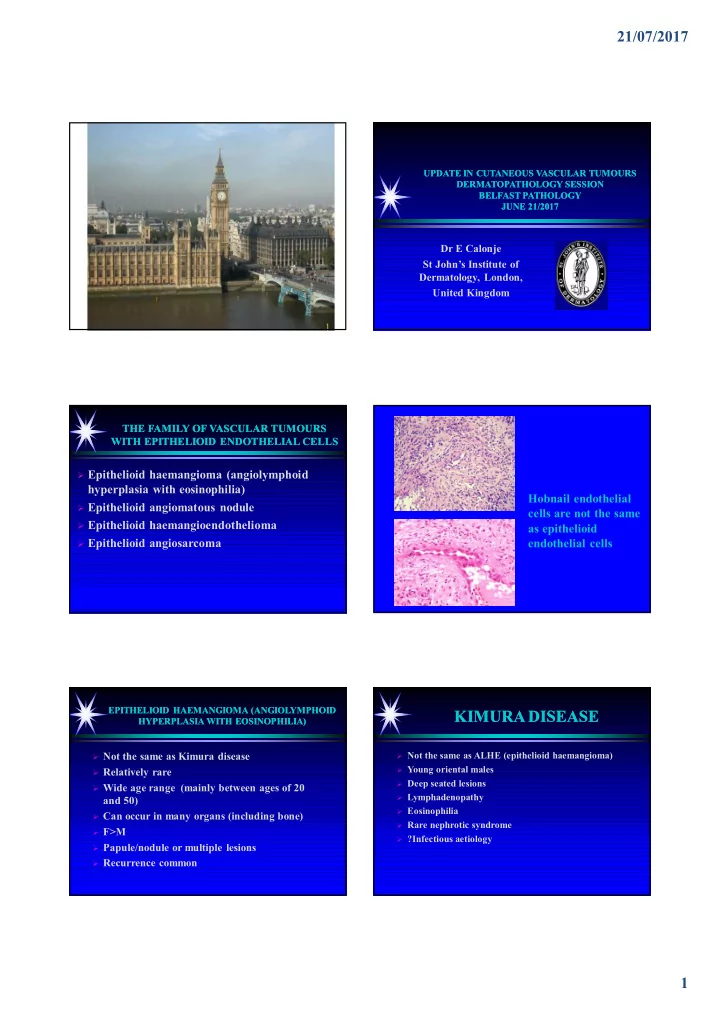

21/07/2017 UPDATE IN CUTANEOUS VASCULAR TUMOURS UPDATE IN CUTANEOUS VASCULAR TUMOURS DERMATOPATHOLOGY SESSION DERMATOPATHOLOGY SESSION BELFAST PATHOLOGY BELFAST PATHOLOGY JUNE 21/2017 JUNE 21/2017 Dr E Calonje St John � s Institute of Dermatology, London, United Kingdom THE FAMILY OF VASCULAR TUMOURS THE FAMILY OF VASCULAR TUMOURS WITH EPITHELIOID ENDOTHELIAL CELLS WITH EPITHELIOID ENDOTHELIAL CELLS � Epithelioid haemangioma (angiolymphoid hyperplasia with eosinophilia) Hobnail endothelial � Epithelioid angiomatous nodule cells are not the same � Epithelioid haemangioendothelioma as epithelioid � Epithelioid angiosarcoma endothelial cells EPITHELIOID HAEMANGIOMA (ANGIOLYMPHOID EPITHELIOID HAEMANGIOMA (ANGIOLYMPHOID KIMURA DISEASE KIMURA DISEASE HYPERPLASIA WITH EOSINOPHILIA) HYPERPLASIA WITH EOSINOPHILIA) � Not the same as Kimura disease � Not the same as ALHE (epithelioid haemangioma) � Young oriental males � Relatively rare � Deep seated lesions � Wide age range (mainly between ages of 20 � Lymphadenopathy and 50) � Eosinophilia � Can occur in many organs (including bone) � Rare nephrotic syndrome � F>M � ?Infectious aetiology � Papule/nodule or multiple lesions � Recurrence common 1
21/07/2017 2
21/07/2017 EPITHELIOID HAEMANGIOMA ANGIOLYMPHOID HYPERPLASIA WITH EOSINOPHILIA 3
21/07/2017 EPITHELIOID HAEMANGIOMA (ANGIOLYMPHOID EPITHELIOID HAEMANGIOMA (ANGIOLYMPHOID EPITHELIOID HAEMANGIOMA (ANGIOLYMPHOID EPITHELIOID HAEMANGIOMA (ANGIOLYMPHOID HYPERPLASIA WITH EOSINOPHILIA) HYPERPLASIA WITH EOSINOPHILIA) HYPERPLASIA WITH EOSINOPHILIA) HYPERPLASIA WITH EOSINOPHILIA) � Lobular architecture � Immunohistochemistry: � CD3 and ERG ++ � Proliferation of vascular channels lined by � EMA and keratins usually negative epithelioid endothelial cells (abundant pink cytoplasm) � Cytogenetics: � Although FOS gene rearrangements have been found in epithelioid � Frequent intracytoplasmic lumina haemangioma of bone, they are usually absent in cutaneous � Inflammation ++ with lymphocytes and lesions. However, immunohistochemistry for FOSB (as in pseudomyogenic haemangioendothelioma) is positive and this is numerous eosinophils therefore useful in differential diagnosis � Germinal centres rare � Fibrosis in late lesions 4
21/07/2017 FOSB Courtesy of B Luzar INTRAVASCULAR EPITHELIOID HAEMANGIOMA INTRAVASCULAR EPITHELIOID HAEMANGIOMA - CLINICAL FEATURES - - CLINICAL FEATURES - Intravascular epithelioid � 16 PATIENTS 12M, 4F � haemangioma 11-71 YRS (MEAN 40,2 YRS) � SIZE FROM 2- 30 MM (MEAN 13 MM) � � 21 LESIONS 13 SOLITARY � 3 MULTIPLE (OF THEM 2 IN THE SAME AREA � DISTAL EXTREMITIES) � � SITE EXTREMITIES (13/21 � 62%) � HEAD AND NECK ( 8/21 � 38%) � � FOLLOW-UP (MEAN 27 MONTHS) NO LOCAL RECURRENCES � 5
21/07/2017 NEURAL GRANULAR CELL NEURAL GRANULAR CELL NEURAL GRANULAR CELL NEURAL GRANULAR CELL TUMOUR TUMOUR TUMOUR TUMOUR NEURAL GRANULAR CELL NEURAL GRANULAR CELL NEURAL GRANULAR CELL NEURAL GRANULAR CELL TUMOUR TUMOUR TUMOUR TUMOUR NEURAL GRANULAR CELL NEURAL GRANULAR CELL NEURAL GRANULAR CELL NEURAL GRANULAR CELL TUMOUR TUMOUR TUMOUR TUMOUR 6
21/07/2017 NEURAL GRANULAR CELL NEURAL GRANULAR CELL NEURAL GRANULAR CELL NEURAL GRANULAR CELL TUMOUR TUMOUR TUMOUR TUMOUR NEURAL GRANULAR CELL NEURAL GRANULAR CELL NEURAL GRANULAR CELL NEURAL GRANULAR CELL TUMOUR TUMOUR TUMOUR TUMOUR CUTANEOUS EPITHELIOID CUTANEOUS EPITHELIOID CUTANEOUS EPITHELIOID CUTANEOUS EPITHELIOID ANGIOMATOUS NODULE ANGIOMATOUS NODULE ANGIOMATOUS NODULE ANGIOMATOUS NODULE � Brenn T, Fletcher CD. Cutaneous epithelioid angiomatous nodule: � Non-ulcerated a distinct lesion in the morphologic spectrum of spithelioid vascular tumors. Am J Dermatopathol. 2004; 26: 14-21 � Polypoid with epithelial collarette � Wide age and anatomical distribution (mainly trunk and limbs) � Well-circumscribed � No sex predilection � Sheets of epithelioid endothelial cells � Mainly solitary but rare multiple or eruptive lesions may be seen � Small papule, superficial and mostly less than 10 mm � Regular with a single nucleolus and vesicular � No tendency for local recurrence nuclei � Benign, part of the spectrum of epithelioid haemangioma � May be mitotic � Little tendency to form vascular channels 7
21/07/2017 8
21/07/2017 EPITHELIOID EPITHELIOID HAEMANGIOENDOTHELIOMA HAEMANGIOENDOTHELIOMA CLINICAL FEATURES � Middle-aged adults � M = F � Extremities > trunk > head/neck � Mainly soft tissues � Often multicentric (bone, viscerae) in up to 50% � 20% metastatic rate � 15% mortality � Small primary cutaneous lesions (good prognosis) EPITHELIOID EPITHELIOID HAEMANGIOENDOTHELIOMA HAEMANGIOENDOTHELIOMA HISTOLOGICAL FEATURES � Frequent angiocentricity � Variable cellularity � Myxoid or hyalinized stroma � Strands or nests � Intracytoplasmic vacuoles � Variable mitotic rate / cytological atypia 9
21/07/2017 EPITHELIOID HAEMANGIOENDOTHELIOMA EPITHELIOID HAEMANGIOENDOTHELIOMA IMMUNOHISTOCHEMISTRY AND CYTOGENETICS IMMUNOHISTOCHEMISTRY AND CYTOGENETICS � Positive for CD31, ERG, FLI-1 and D2-40 � 20% positive for keratin and EMA � WWTR1 � CAMTA1 fusion in up to 90% (CAMT1 immunohistochemistry useful in differential diagnosis as tumours positive in up to 86%) � Rarely YAP1 � TFE3 fusions 10
21/07/2017 EPITHELIOID EPITHELIOID Primary cutaneous epithelioid angiosarcoma: a ANGIOSARCOMA ANGIOSARCOMA clinicopathologic study of 13 cases of a rare neoplasm occurring outside the setting of CLINICAL FEATURES conventional angiosarcomas and with predilection for the limbs. � Rare Suchak R, Thway K, Zelger B, Fisher C, Calonje E. � Mainly in deep soft tissues Am J Surg Pathol. 2011 Jan;35(1):60-9 . � Primary lesions can occur in many organs � Middle to old age � M > F � Haemorrhagic papules / nodules � Often aggressive EPITHELIOID ANGIOSARCOMA EPITHELIOID ANGIOSARCOMA CLINICAL FEATURES � Rare � Pure epithelioid tumours represent a subset of lesions that occurs outside the three classic clinical groups of cutaneous angiosarcomas (idiopathic of the head and neck, chronic lymphoedema-associated angiosarcoma and post-radiotherapy angiosarcoma) � Mainly in deep soft tissues � Primary lesions can occur in many organs � Middle to old age � M > F � Haemorrhagic papules / nodules � Often aggressive � Mortality is as high as 55% in 3 years 11
21/07/2017 EPITHELIOID ANGIOSARCOMA EPITHELIOID ANGIOSARCOMA HISTOLOGICAL FEATURES � Infiltrative and diffuse � Dermal and often subcutaneous � Sheets of large atypical epithelioid endothelial cells with abundant pink cytoplasm, vesicular or hyperchromatic nuclei and a single prominent nucleolus � Frequent mitotic figures/variable necrosis � Intracytoplasmic lumina with or without red blood cells frequent � Blood vessel formation rare � May be intravascular (in such cases rule-out origin from a large blood vessel with embolization) � Immunohistochemical profile: CD31, FLI-1 and ERG positive. In up to 40% or more at least focal positivity for pan-keratin and also for EMA. CD34 variable positivity 12
Recommend
More recommend